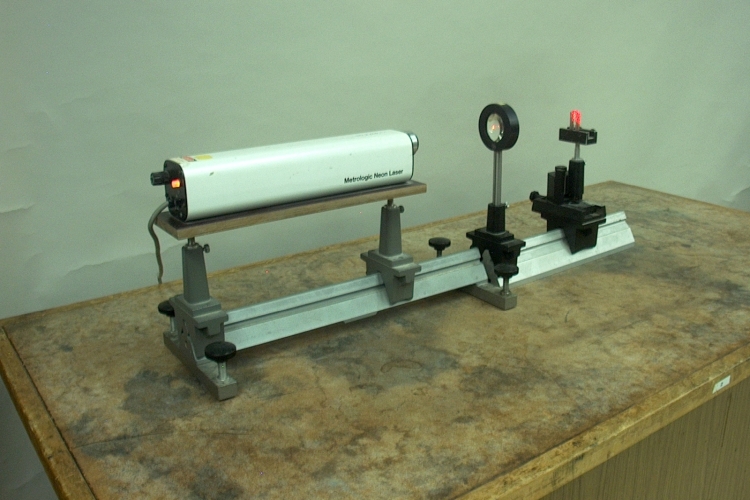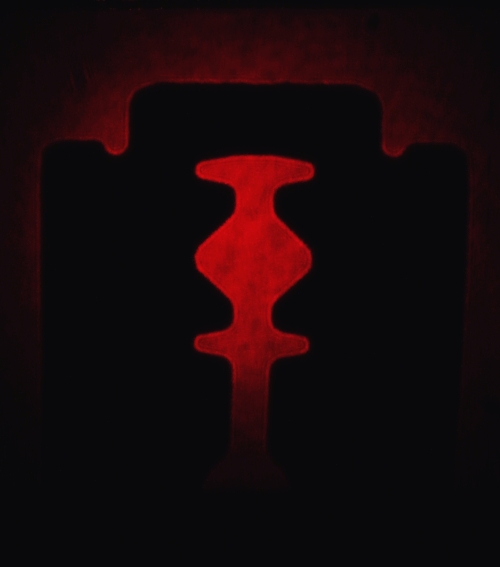 |
 |
A razor blade placed in an expanded laser beam produces a diffraction pattern on a screen (shown above in the photograph at right; to see a larger version of this image, click on the photograph).
Demonstration 84.06 – Laser beam diffracted through various slits, illustrates the diffraction of light by single slits of various widths, and double slits of various widths and separations. The key element in this phenomenon is what happens to light as it passes near the edge of an object. In this demonstration, the object is a double-edged razor blade, whose opening is much larger than any of the slits used in demonstration 84.06, and for which we observe a diffraction pattern along the shadow of the outer edge, visible along the shadow of the top end of the razor blade, as shown in the photograph above. (You can move the blade vertically and horizontally to emphasize different parts of the diffraction pattern, if you wish.) Because the light is not constrained by a narrow slit, but can travel from a relatively large region near the edge of the blade, and the opening within the blade is relatively large, the geometry is slightly different from that in demonstration 84.05. Light rays arriving at a particular spot on the screen do not all reach that point from the same angle with respect to the plane of the razor blade, but travel over a small range of angles. The diffraction phenomenon is identical to what occurs with slits, except that the intensity variation in the series of maxima and minima is different from that observed in the diffraction pattern from a slit. Diffraction under these conditions is often referred to as Fresnel diffraction.
One can analyze such systems by considering points along a cylindrical wavefront traveling past the edge toward a point on a screen placed far from the edge. Summing the contributions from all points on the wavefront to the amplitude of the light that reaches the point on the screen, one obtains an integral of a cosine function and an integral of a sine function, each having the same argument, which is determined by the geometry of the system and the wavelength of the light passing the edge. These are called Fresnel's integrals. Plotting these integrals against each other, with the values of the cosine integral on the x-axis and those of the sine integral on the y-axis, yields a curve called Cornu's spiral. The length of the chord taken from one end point of the spiral (the end that lies in the positive quadrant; see the diagram here) to the point on the spiral that corresponds to a particular point on the screen, gives the amplitude of the light at that point, or the square root of its intensity.
Richard Feynman describes the process of taking points along a line extending from the edge (in the plane of the edge, perpendicular to it and parallel to the distant screen), and adding infinitesimal vectors from all the points, where the vectors point at angles that correspond to the differences in the phases among them, which are determined by the geometry of the system. Doing this results in the same spiral shown at the links above, and using it as shown in detail in the second link above gives the intensity profile shown there and illustrated by the photograph above. Around the shadow of the blade, you can see a series of alternating parallel bright and dark lines along the entire top edge, and a similar pattern inside the opening in the middle of the blade.
References:
1) Jenkins, Francis A. and White, Harvey E. Fundamentals of Optics, Second Edition (New York: McGraw-Hill Book Company, Inc., 1950), pp. 358-368. This book gives a thorough explanation of the theory of Fresnel diffraction, as well as Fraunhofer diffraction. Chapter 18 covers Fresnel diffraction. The pages cited above contain the topics of cylindrical wave fronts, Fresnel’s integrals, vibration curve for strip division (Cornu’s spiral), and diffraction by a straight edge. The text is accompanied by helpful diagrams, and photographs of the diffraction pattern and a microphotometer trace of it.
2) Feynman, Richard P., Leighton, Robert B. and Sands, Matthew. The Feynman Lectures on Physics, Volume 1 – Mainly Mechanics, Radiation and Heat (Menlo Park, California: Addison-Wesley Publishing Company, 1963), pp. 30-1, 30-8,9.
3) http://hyperphysics.phy-astr.gsu.edu/hbase/phyopt/difopa.html#c1 and links to related topics.
4) http://hyperphysics.phy-astr.gsu.edu/hbase/phyopt/cornu.html#c1 and links to related topics.